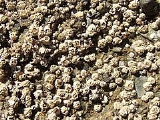
Balanus glandula
Encyclopedia
Balanus glandula is one of the most common barnacle
species on the Pacific coast
of North America
, distributed from the U.S. state
of Alaska
to Bahía de San Quintín near San Quintín, Baja California
. It is commonly found in intertidal waters on mussel
s, rocks and pier pilings.
It is a moderate-sized barnacle with a diameter of up to 22 mm (0.866141732283465 in). The shell is formed by overlapping plates. It is has more the shape of a cylinder than the shape of a cone. The white operculum
has heavily ridged walls. It can live up to ten years.
It has been intensely studied in recent years as a model species for linking physical oceanography
and population genetics
(or phylogeography
) surveys. This species was introduced to the shores of Argentina
in the 1970s, and has become an invasive species
, displacing other barnacles and mussels.
Barnacle
A barnacle is a type of arthropod belonging to infraclass Cirripedia in the subphylum Crustacea, and is hence related to crabs and lobsters. Barnacles are exclusively marine, and tend to live in shallow and tidal waters, typically in erosive settings. They are sessile suspension feeders, and have...
species on the Pacific coast
Pacific Ocean
The Pacific Ocean is the largest of the Earth's oceanic divisions. It extends from the Arctic in the north to the Southern Ocean in the south, bounded by Asia and Australia in the west, and the Americas in the east.At 165.2 million square kilometres in area, this largest division of the World...
of North America
North America
North America is a continent wholly within the Northern Hemisphere and almost wholly within the Western Hemisphere. It is also considered a northern subcontinent of the Americas...
, distributed from the U.S. state
U.S. state
A U.S. state is any one of the 50 federated states of the United States of America that share sovereignty with the federal government. Because of this shared sovereignty, an American is a citizen both of the federal entity and of his or her state of domicile. Four states use the official title of...
of Alaska
Alaska
Alaska is the largest state in the United States by area. It is situated in the northwest extremity of the North American continent, with Canada to the east, the Arctic Ocean to the north, and the Pacific Ocean to the west and south, with Russia further west across the Bering Strait...
to Bahía de San Quintín near San Quintín, Baja California
San Quintín, Baja California
San Quintín is a coastal town on the west coast of the Mexican state of Baja California, in the municipio of Ensenada. San Quintín has beautiful beaches and several places for tourists to stay. Tourists can enjoy fishing, camping, bird watching, surfing, and clam digging...
. It is commonly found in intertidal waters on mussel
Mussel
The common name mussel is used for members of several families of clams or bivalvia mollusca, from saltwater and freshwater habitats. These groups have in common a shell whose outline is elongated and asymmetrical compared with other edible clams, which are often more or less rounded or oval.The...
s, rocks and pier pilings.
It is a moderate-sized barnacle with a diameter of up to 22 mm (0.866141732283465 in). The shell is formed by overlapping plates. It is has more the shape of a cylinder than the shape of a cone. The white operculum
Operculum (gastropod)
The operculum, meaning little lid, is a corneous or calcareous anatomical structure which exists in many groups of sea snails and freshwater snails, and also in a few groups of land snails...
has heavily ridged walls. It can live up to ten years.
It has been intensely studied in recent years as a model species for linking physical oceanography
Physical oceanography
Physical oceanography is the study of physical conditions and physical processes within the ocean, especially the motions and physical properties of ocean waters.Physical oceanography is one of several sub-domains into which oceanography is divided...
and population genetics
Population genetics
Population genetics is the study of allele frequency distribution and change under the influence of the four main evolutionary processes: natural selection, genetic drift, mutation and gene flow. It also takes into account the factors of recombination, population subdivision and population...
(or phylogeography
Phylogeography
Phylogeography is the study of the historical processes that may be responsible for the contemporary geographic distributions of individuals. This is accomplished by considering the geographic distribution of individuals in light of the patterns associated with a gene genealogy.This term was...
) surveys. This species was introduced to the shores of Argentina
Argentina
Argentina , officially the Argentine Republic , is the second largest country in South America by land area, after Brazil. It is constituted as a federation of 23 provinces and an autonomous city, Buenos Aires...
in the 1970s, and has become an invasive species
Invasive species
"Invasive species", or invasive exotics, is a nomenclature term and categorization phrase used for flora and fauna, and for specific restoration-preservation processes in native habitats, with several definitions....
, displacing other barnacles and mussels.

